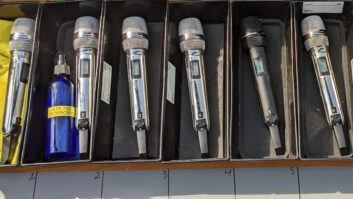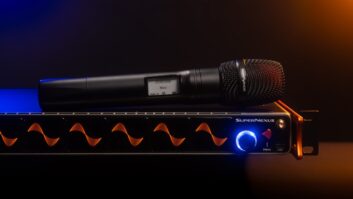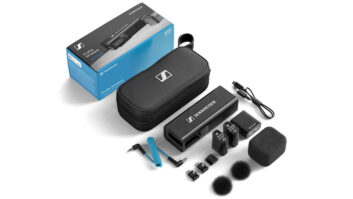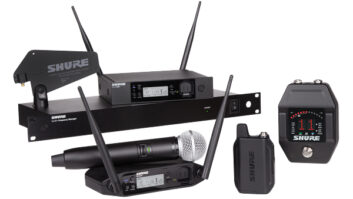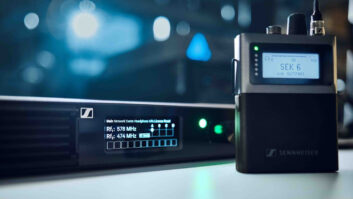by Clive Young.
New York–As Congress tries to decide whether to push back the long-planned transition to Digital TV on February 17, a lesser-known digital move-out will take place the same day…and many of the people it affects are completely unaware of it.
Last year, the FCC reallocated and partially auctioned off the 698 MHz to 806 MHz spectrum, generally referred to as the 700 MHz frequency band. The space, previously used for TV channels 52 through 69, will now be home to public safety and commercial users–which means wireless mic users with gear operating in that spectrum have to vacate the premises by mid-February. Many end-users, however, have no idea that the move is coming.
“Among those who are actually touching the mics and using them–musicians, houses of worship, etcetera–people are pretty much in the dark,” said Michael Pettersen, Shure‘s director of applications engineering.
Many fellow manufacturers concur. “We’ve gotten a lot of calls in the last month as people learned of it, but considering the number of units that are out in the field, very few people are aware of the situation,” said Dave Egenberger, wireless mic product manager, Electro-Voice.
“In general, rental houses and broadcasters have been on top of the issue, as well as many houses of worship, but many independent musicians and video producers only heard about it recently,” confirmed Joe Ciaudelli, wireless spokesperson for Sennheiser. Joseph Wagoner, product manager for wireless tour/installed sound at AKG, predicted, “There will be a lot of end users who operate one or two wireless systems who are not going to be aware until they are forced one way or another to confront this issue. I believe most manufacturers have made a great effort to get the word out on this issue to their customers and to the general public.”
If end users are unaware of their upcoming legal responsibilities regarding wireless mics, it wouldn’t be the first time; Cliff Castle, vice president of sales and marketing at Audix, noted, “My sense is that most end users are not aware of the change, and if they are, they are probably confused about what it means; after all, most users are not aware that they are required by FCC to have a license to operate wireless systems.”
The FCC itself is adding to the confusion, having yet to offer definitive rulings on many aspects of the transition, despite the fact that the massive mic migration is only a few weeks away. Notably, there are currently no set parameters on how the move will take place or what happens to users who may unwittingly use the frequency band after February 17.
That said, the FCC has moved forward on a few issues, as Jackie Green, vice president of R&D engineering at Audio-Technica, pointed out, noting, “No further type approvals are being allowed for 700 MHz systems–this means no new product development or importation in this band. However, the FCC has not yet stated how it will handle existing licensed wireless users in the 700 MHz band. We are hoping–and requesting–that if existing users are asked to vacate, the FCC considers a two-year transition period.”
That may or may not happen–many wireless microphone manufacturers banded together through the Professional Audio Manufacturers Alliance (PAMA) trade group to file ex parte comments with the FCC on January 5 regarding expected negative effects of a hasty, disruptive transition. For those manufacturers, it’s imperative that they make their customers aware of the changes arriving in the coming weeks. Audix’s Castle explained, “As a secondary user, you must not interfere with users holding a license to operate. The FCC will hunt you down if, as a low power secondary user, you are causing interference for any of the legal owners of this bandwidth, and you will be asked to shut down your systems, licensed user or not.”
Hoping to drive the point home, companies investing in the reallocated 700 MHz spectrum are lobbying the FCC to levy heavy fines against mic users who trespass into the spectrum. Whether any wireless mic users would actually be hit with a fine, however, is another story.
Karl Winkler, director of business development, Lectrosonics, opined, “It is highly unlikely that the FCC will have the resources to police the spectrum, because they can’t do it right now in the UHF band in general. They have essentially turned a blind eye to the use of wireless mics over the past several decades, since the use of these products has been largely benign. The only instances where I could see the FCC getting involved is if one of the spectrum owners has reports of interference, and it is tracked down to a wireless mic user–but since UHF wireless mic systems are so low powered, even this is an unlikely scenario.”
Even so, wireless mic users who plan to cross their fingers and continue using the 700 MHz band may be looking for trouble. Sennheiser’s Ciaudelli offered, “Once the FCC ratifies a deadline prohibiting wireless mic use in that band, heavy fines could be levied on anyone that does not comply. Typically, the FCC reacts to specific complaints, and they are likely to be far more vigilant with complaints of unauthorized use of channels 63-64 (764-776 MHz) and 68-69 (794-806 MHz) which are reserved for emergency communication.”
It’s worth pointing out, however, that wireless mic users will have other reasons to move on; once the spectrum’s new tenants move in, the 700 MHz band will likely remind wireless mic users of Baseball great Yogi Berra’s famous quote: “Nobody goes there anymore; it’s too crowded.”
According to Shure’s Pettersen, “What will ultimately happen is that users may one day find that they are taking hits and getting interference from new devices using the bandwidth. Instead of transmitting 100 feet, they will only go about 10, and so on. Changes are coming, and we all have to prepare.”
For AKG’s Wagoner, however, that’s something worth welcoming: “I believe it to be a catalyst for change; this is a historic time with the change to all digital television–and with change comes opportunity. At AKG Acoustics USA, we have a great opportunity to present some of the new products.”
An influx of new wireless gear into the hands of end-users will do more than benefit the manufacturers; Lectrosonics’ Winkler pointed out, “users with low-cost, low-quality wireless mics will have to replace them, and this is not a bad thing for the industry or the users. This change in regulation may provide the impetus for them to go ahead and budget for new systems.”
For end users who don’t have the financial reserves at the moment, there’s hope for them too–at least temporarily, as EV’s Egenberger observed: “In the short term, once they turn off the analog TV stations below 700 MHz, there’s more spectrum available to us in the short term. Till they open up the whole white space thing–which is a totally separate issue.”
Audio-Technica’s Jackie Green took perhaps the widest view of the situation, however, and pointed out a critical factor that could be easily overlooked: “We should not forget that one very important reason the FCC is clearing this band is to ensure coordinated safety communications for everyone. That certainly qualifies as a silver lining.”


